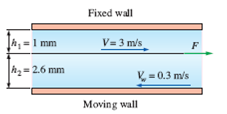#606 A thin 30-cm × 30-cm flat plate is pulled at
A thin 30-cm × 30-cm flat plate is pulled at - Mechanical Engineering
ChemistryExplain daily providing Q&A content “#606 A thin 30-cm × 30-cm flat plate is pulled at" in Mechanical Engineering, Best colleges for mechanical engineering, Entry level mechanical engineer, Mechanical engineering companies
Get the Free Online Chemistry Q&A Questions And Answers with explain. To crack any examinations and Interview tests these Chemistry Questions And Answers are very useful. Here we have uploaded the Free Online Chemistry Questions. Here we are also given the all chemistry topic.
ChemistryExplain team has covered all Topics related to inorganic, organic, physical chemistry, and others So, Prepare these Chemistry Questions and Answers with Explanation Pdf.
For More Chegg Questions
Join Our Telegram Channel for Covers All Update by ChemistryExplain:- Click Now
Free Chegg Question
A thin 30-cm × 30-cm flat plate is pulled at 3 m/s horizontally through a 3.6-mm-thick oil layer sandwiched between two plates, one stationary and the other moving at a constant velocity of 0.3 m/s, as shown in Fig. P2–81. The dynamic viscosity of the oil is 0.027 Pa·s. Assuming the velocity in each oil layer to vary linearly, (a) plot the velocity profile and find the location where the oil velocity is zero and (b) determine the force that needs to be applied on the plate to maintain this motion.
FIGURE P2–81
Free Chegg AnswerFor More Chemistry Notes and Helpful Content Subscribe Our YouTube Chanel - Chemistry Explain
Free Chegg Answer
-
Step 1 of 5
(a)
Calculate the surface area of the plate.
Here, A is the surface area.
Consider the portion of the oil that is below the plate.
Calculate the viscous force acting in the plate in this portion.
Here,
is the viscous force,
is the coefficient of viscosity, V is the velocity of the plate,
is the velocity of the oil,
is the change in velocity in the lower portion, and
is the thickness of the oil layer in the lower portion.
Substitute
for
,
for A,
for V, for
, and 0.0026 m for
.
-
Step 2 of 5
Calculate the location where the velocity of the oil is zero.
Substitute
for
,
for A,
for , 0 for
, and
for
.
In the upper portion the velocity of the oil is zero at the surface of the fixed wall.
Hence, the location where the oil velocity is zero in the lower potion is
from the plate.
-
Step 3 of 5
Draw the velocity profile of the fluid:
-
Step 4 of 5
(b)
Consider the portion of the oil that is above the plate.
Calculate the viscous force acting in the plate in this portion.
Here,
is the viscous force,
is the coefficient of viscosity,
is the change in velocity in the upper portion, and
is the thickness of the oil layer in the upper portion.
Substitute
for
,
for A,
for , and 0.001 m for
.
-
Step 5 of 5
Calculate the force that needs to be applied to maintain this motion.Here, F is the total force applied on the plate.
Substitute 7.29 N for
and
for
.
Therefore, the force that needs to be applied to maintain this motion is
.
Labels: Chegg, Free Chegg Answer, Q&A Mechanical Engineering
















0 Comments:
Post a Comment
Subscribe to Post Comments [Atom]
<< Home